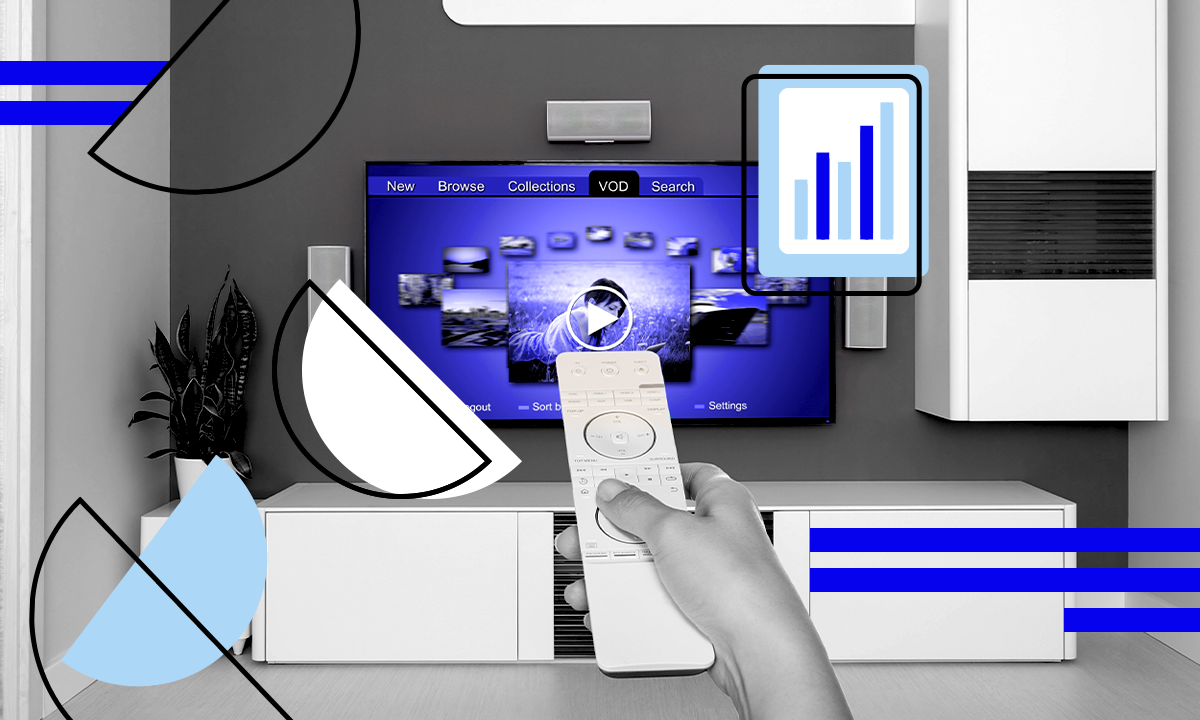
CTV Measurement Is Gaining Ground Despite Adoption Challenges
There’s no denying that the use of connected TV (CTV) has been on the rise in recent years, and the pandemic only cemented its strong position in the home entertainment niche. This did not go unnoticed by marketers, especially considering that in 2021, according to new consumer research from Leichtman Research Group, 82% of US households will already have access to it – and brands are aware of this too.
A recent study by Innovid and the ANA says that CTV ad spend will exceed $11 billion in the country this year and is expected to grow x1.6 by 2024. CTV has surely become an integral part of omnichannel marketing, with ad tech solutions helping the cause in their own right.
Nevertheless, even marketing professionals often fail to grasp how the technology works, especially the measurement side of it. With three layers consisting of publishers, platforms and devices in between them, it can be a hard nut to crack. 57% of marketers called inconsistent measurement the biggest challenge to connected TV advertising, with inventory fragmentation, frequency and reach coming next with 41%, 32% and 22% respectively.
So how do we measure CTV ads? Let’s take a closer look at what tools marketers can put to use to make measuring advertising effectiveness less daunting and get more out of their investment on the big screen.
Connected TV Measurement Challenges
CTV measurement sets out to track and analyze the outcome of video ad campaigns through OTT/CTV channels. Bearing in mind the goals of a campaign, different metrics are used to evaluate its success. The measurement of connected TV is unlike linear TV, nor is it like mobile or PC. This recently discovered territory is fragmented, with multiple devices, an absence of common identifiers between platforms, various measurement tools and offerings from streaming platforms themselves, as well as third-party solutions.
OTT and CTV platforms stand out by offering entirely personalized experiences to viewers on the basis of their profiles that take into account watching history and IP address information. While CTV ad measurement still has a long way to grow, conclusions inferred even at this stage demonstrate it as more specific and fine-tuned.
Measurement of Connected and Linear TV: There’s a Difference
Linear TV
Measurement is probably one of the weakest points of linear TV. Though advertisers can address a great number of viewers it is hard to identify how the ads are viewed and whether they are viewed at all. Moreover, there is no possibility of getting the information about the audience and retrieving other important performance data. Targeting is based on demographic, viewers’ age, and household income levels.Commercials are shown at certain times of the day taking into account a program’s ratings but the audience is not segmented.
To understand whether their commercials were effective or not, advertisers use various analytics measurement tools to monitor the changes in traffic – after ads are displayed, activity may be higher. It is also possible to add QR-codes and tracking numbers to the commercials but there is still no chance to find out how many users viewed the ad. The possibilities of CTV measurement are richer and contain a broad set of metrics that can be used in measuring the success of ad campaigns.
Connected TV
CTV is distinguished by a programmatic approach, and advertisers purchase the necessary amount of impressions. Detailed reports are available in real-time with all the data about ad delivery and campaign performance.
Another valuable measurement characteristic of CTV ads is high completion rate. It can reach 90% because the ads usually can’t be skipped, and 10% is given to the cases when a viewer turns off the video during the commercial.
Return on the ad spend (ROAS) is another metric to mention for CTV ad measurement. In this case, it is not about precision but the overall understanding of how much value advertisers get for their ads. And in order to track profit per dollar of ad spend, advertisers use ROI – return on investment metric.
CTV Advertising Measurement Metrics
Among the common metrics used in digital advertising measurement are reach, impressions, and cost per completed view. On the other hand, performance advertisers consider the above along with verified visits, conversion, return on ad spend, and other measurement metrics offering insights into consumer behavior after an ad is viewed. The success of an individual ad or campaign is usually determined by several advertising measurement methods offering a wider picture, as opposed to just one. Below are some of the most common of those:
Campaign Impressions – The number of times ad content has been displayed, no matter if it was viewed or not.
Total Reach – The total number of unique households exposed to a single or set of campaigns.
Completion Rate – The number of times a full ad was viewed. This shows how many people actually watched the ad in its entirety.
View Through Rate (VTR) – This metric measures video completion rates in terms of how often an ad was seen in full by viewers.
Ad Viewability Score – It is counted if an ad is watched for a few seconds and appears on more than 50% of the screen.
Attribution and Attribution Tracking – This proves the ad campaign ROI by linking viewership to conversion, which can be visiting a website, downloading an app or even visiting a store in real life.
Cost Per Mille (CPM) – If you were asked how to measure digital advertising, this would be one of the most common metrics. This is the general cost of one thousand impressions.
Cost Per Completed View – This is a more meaningful measurement metric – a ratio of the total cost of a campaign and the total number of completed views.
To fully take advantage of these measurement metrics, audience behaviors must be accurately tracked to individual ads within each campaign. This will indicate what to focus on, what ads are not working, and even what “style” of ads to use in future campaigns for the best results.
How to Increase the Effectiveness of CTV Ad Campaigns
Detailed campaign reporting is the key to success. Using detailed reporting and inventory forecasting, provided by TheViewPoint, customers are able to make data-driven programmatic buying and selling decisions. Advertisers can collect information and track measurement metrics to change a campaign considering the latest analytics or evaluate their creative approaches via A/B testing.
Marketers should determine KPIs for each CTV campaign accurately and separately. Different tasks demand different tools. For example, if the only campaign goal is to raise brand awareness, completion rate measurement metrics alone would suffice.
Don’t disregard linear TV ad measurement metrics. Gross Rating Points (GRPs) and Television Rating (TVRs) can also work in CTV and often prove to be an effective interim indicator.
Programmatic advertising utilizes flexible smart algorithms to deliver the most relevant advertisements to the most suitable audiences at the right time helping buyers and sellers achieve their goals more quickly. There is also a possibility of using a supply side platform to save time and effort. And if marketers were wondering how to measure programmatic advertising considering the amount of data, it is no longer as challenging as it once was.
Takeaways
Although CTV advertising measurement is not that simple, important steps have been taken to make it more accessible to all parties involved. For marketers, the data, technology, and industry benchmarks are already within easy reach, ensuring that CTV advertising is gradually becoming more transparent and effective.
All in all, the outlook for the industry is predominantly positive, and with wider adoption and the emergence of bespoke solutions, such as private marketplaces, the niche will have something to offer to all brands.
Related
Programmatic TV Tax Day is Not Just April 15. It's Every Day
This blog examines the significant "AdTech tax" in Connected TV advertising, advocating for Tatari's direct integration with publishers to bypass hidden fees, resulting in substantial cost savings and enhanced transparency.
Read more
Ad Pod And its Friends: Delivering the Best CTV Ad Experiences
Aiming to stand out from the crowd and surpass consumers’ expectations, CTV advertisers have to be allied with publishers and very savvy at applying innovative advertising techniques, like frequency capping, competitive ad separation, and deduplication. Though still raising a lot of eyebrows, these tools have already become the next big thing in the advertising world. So, before diving deep into the details of ad pod management, let’s take a sneak peek behind the scenes of modern CTV play.
Read more
Everything You Need to Know About Real-Time Bidding
As programmatic advertising is gaining momentum, RTB or real-time bidding comes in. In fact, most platforms in ad tech today are RTB enabled. But what does that actually mean? What is an RTB platform and why is it so important for digital marketers? Let’s get the answers to these questions and more.
Read more


